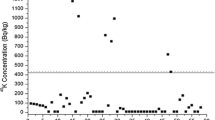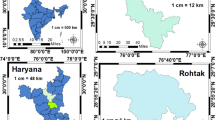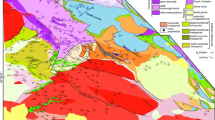Abstract
A comprehensive radio-ecological evaluation of soil samples of Solan and Shimla districts of Himachal Pradesh has been carried out for risk and dose assessment. Twenty-six randomly selected environmental soil samples were analysed for natural radionuclide concentrations (226Ra, 232Th and 40K) using NaI(Tl) scintillator detector. The average concentration of 226Ra, 232Th and 40K was observed as 37, 59 and 430 Bq kg−1, respectively, which exceeded the worldwide average of 33, 45 and 412 Bq kg−1 reported by UNSCEAR (Sources and effects of ionizing radiation. Report to the general assembly with scientific annexes, New York, 2008). Radium equivalent activity (Raeq), hazard indices (Hex, Hin) and radioactivity level indices (Iϒr, Iα, AUI) and Clark value were checked against their threshold limits, and their mean values were safely below the recommended criteria. This confirms the soil applicability for construction purposes. Indoor and outdoor dose rates (Ḋ), age-dependent annual effective doses (AED), organ-specific doses and lifetime attributable cancer risk (both cancer incidence and cancer mortality) were also computed. Strong positive correlation was established between radon/thoron exhalation rate and their parent radionuclides. Multivariate statistical technique was employed to explore spatial distribution of radionuclides and homogeneity between various radiological parameters.














Similar content being viewed by others
Abbreviations
- A R :
-
Activity concentration of a particular radionuclide (Bq kg−1)
- N E :
-
Net area of the peak (background subtracted) at energy E
- T :
-
Counting time for a sample in NaI detector (s), 10,800
- ϒ :
-
Gamma energy yield per disintegration of the specific radionuclide at energy E, 15.1 for 214Bi, 35.64 for 208Tl, 10.67 for 40K
- ε :
-
Absolute full-energy peak detection efficiency of detector at energy E, 1.13 for 226Ra, 0.77 for 232Th, 1.352 for 40K
- m :
-
Total mass of the dry soil sample inside the chamber or container (kg)
- R B :
-
Background count rate of detector
- t G :
-
Gross count time (s)
- t B :
-
Background count time (s)
- C Rn(t):
-
Radon concentration inside the accumulation chamber at any time t ≠ 0 (Bq m−3)
- J m :
-
Radon mass exhalation rate (Bq kg−1 h−1)
- V e :
-
Effective volume (residual air volume of exhalation chamber + Porous Volume of sample + internal volume of SMART RnDuo/RAD7) (m3), 0.0015
- λ e :
-
Effective radon decay constant which is sum total of leakage constant (assumed zero), back diffusion (negligible) and radioactive decay constant (h−1)
- C 0 :
-
Radon concentration present in chamber volume at time t = 0 (Bq m−3)
- J s :
-
Thoron surface exhalation rate (Bq m−2 h−1)
- C Tn :
-
Thoron concentration (Bq m−3)
- λ Tn :
-
Radioactive decay constant for thoron (s−1), 0.0126
- V :
-
Volume enclosed in the closed loop (m3)
- A :
-
Cross-sectional area of the accumulation chamber (m2)
- E Rn :
-
Emanation rate of radon (kg−1 s−1)
- \(C_{{{\text{Rn}}}}^{s}\) :
-
Steady-state concentration of radon (Bq m−3)
- F Rn :
-
Emanation coefficient of radon
- E C :
-
Elemental concentration of a radionuclide (ppm or %)
- M w :
-
Molecular weight of radionuclide (kg mol−1), 0.238 for 238U, 0.232 for 232Th, 0.039 for 40K
- F :
-
A constant (mg kg−1 or ppm for 238U, 232Th and % of mass fraction for 40K), 106 for 238U, 232Th, 102 for 40K
- N A :
-
Avagadro’s number (atoms mol−1), 6.022 × 1023
- λ :
-
Decay constant of a radionuclide (s−1), 4.9 × 10−18 for 238U, 1.6 × 10−18 for 232Th, 1.8 × 10−17 for 40K
- h E :
-
Atomic abundance in nature (%),99.2745 for 238U, 99.98 for 232Th, 0.012 for 40K
- f Ra, f Th, f K :
-
Fractional contributions to the total dose rate in air attributed to gamma radiation from the actual concentrations of 226Ra, 232Th and 40K, respectively, fRa = 0.462, ffTh= 0.604, ffK= 0.0417
- w m :
-
Fractional usage of a building material inside the dwelling
- OF:
-
Occupancy factor, 0.8 for indoors, 0.2 for indoors
- k :
-
Ratio of mass absorption coefficients in organ and air
References
Adam, A. M. A., & Eltayeb, M. A. H. (2012). Multivariate statistical analysis of radioactive variables in two phosphate ores from Sudan. Journal of Environmental Radioactivity, 107, 23–43.
Ahmad, N., Hussein, A. J. A., & Aslam, S. (1998). Radiation doses in Jordanian dwellings due to natural radioactivity in construction materials and soil. Journal of Environmental Radioactivity, 41, 127–136. https://doi.org/10.1016/s0265-931x(98)00007-1
BEIR Vii. (2006). Health risks from exposure to low levels of ionizing radiation, Phase II. National Research council. Washington, DC: National Academy Press.
Cothern, C.R. (1987). Environmental radon. In: Michel, J., (ed.), Chapter 4, sources. New York: Plenum Press.
Dragovic, S., Lj, J., Onjia, A., & Bacic, G. (2006). Distribution of primordial radionuclides in surface soils from Serbia and Montenegro. Radiation Measurements, 41, 611–616. https://doi.org/10.1016/j.radmeas.2006.03.007
EC. (1999). Radiation protection 112. Directorate-General Environment, Nuclear Safety and Civil Protection: Radiological protection principles concerning the natural radioactivity of building materials.
Gaware, J. J., Sahoo, B. K., Sapra, B. K., et al. (2011). Development of online radon and thoron monitoring systems for occupation and general environments. BARC News Letters, 318, 45–51.
Gbadamosi, M. R., Afolabi, T. A., Ogunneye, A. L., Ogunbanjo, O. O., Omotola, E. O., Kadiri, T. M., et al. (2018). Distribution of radionuclides and heavy metals in the bituminous sand deposit in Ogun State, Nigeria: a multi-dimensional pollution, health and radiological risk assessment. Journal of Geochemical Exploration, 190, 187–199.
Groeneveld, R. A., & Meeden, G. (1984). Measuring Skewness and Kurtosis. The Statistician, 33(4), 391–399.
Guagliardi, I., et al. (2016). Effects of source rocks, soil features and climate on natural gamma radioactivity in the Crati valley (Calabria, Southern Italy). Chemosphere, 150, 97–108.
Gulan, L., Milenkovic, B., Stajic, J. M., Vuckovic, B., Krstic, D., Zeremski, T., & Ninkov, J. (2013). Correlation between radioactivity levels and heavy metal content in the soils of the North Kosovska Mitrovica environment. Environmental Science Processes and Impacts, 15, 1735–1742.
Harikrishnan, N., Ravisankar, R., Chandrasekaran, A., Gandhi, M. S., Vijayagopal, P., & Mehra, R. (2018). Assessment of gamma radiation and associated radiation hazards in coastal sediments of south east coast of Tamil Nadu, India with statistical approach. Ecotoxicology and Environmental Safety, 162, 521–528.
Hassan, N. M., Hosoda, M., Ishikawa, T., Sorimachi, A., Sahoo, S. K., Tokonami, S., & Fukushi, M. (2009). Radon migration process and its influence factors; Review. Japanese Journal of Health Physics, 44(2), 218–231.
IAEA. (2004). Application of the concepts of exclusion, exemption and clearance in safety standards series No. RS-G-1.7.
ICRP. (1994). Protection against radon-222 at home and at work (ICRP Publication 65). Ann. ICRP 23(2). Oxford: Pergamon Press.
ICRP. (1999). Protection of the public in situations of prolonged radiation exposure. ICRP Publication 82. Ann. ICRP 29 (1–2).
ICRP. (2007). Recommendations of the international commission on radiological protection. ICRP Publication 103, Annals of the ICRP. Oxford: Pergamon Press.
ICRP. (2010). Conversion coefficients for radiological protection quantities for external radiation exposures. ICRP Publication 116, Ann ICRP 40 (2–5). Oxford, UK.
Kakati, R. K., Kakati, L., & Ramachandran, T. V. (2013). Measurement of uranium, radium and radon exhalation rate of soil samples from Karbi Anglong district of Assam, India using EDXRF and Can technique method. APCBEE Procedia., 5, 186–191.
Kaur, S., & Mehra, R. (2018). Toxicological risk assessment of protracted ingestion of uranium in groundwater. Environmental Geochemistry and Health, 41(2), 681–698. https://doi.org/10.1007/s10653-018-0162-4
Kok, K. (2009). Nuclear engineering handbook. Ohio: CRC Press. ISBN: 978-1-4200-5390-5
Krisiuk, E.M., Tarasov, S.I., Shamov, V.P., Shalk, N.I., Lisachenkov, E.P., & Gomelsky, L.G. (1971). A study of radioactivity in building materials. Leningrad Research Institute for Radiation Hygiene.
Kumar, R., Sengupta, D., & Prasad, R. (2003). Natural radioactivity and radon exhalation studies of rock samples of Surda copper deposits in Singhbhum shear zone. Radiation Measurements, 36, 551–553.
MacKenzie, A. B. (2000). Environmental radioactivity: experience from the 20th century-trends and issues for the 21st century. Science of the Total Environment, 249, 313–329.
Mahur, A. K., Kumar, R., Sengupta, D., & Prasad, R. (2008). Estimation of radon exhalation rate, natural radioactivity and radiation doses in fly ash samples from Durgapur thermal power plant, West Bengal, India. Journal of Environmental Radioactivity, 99, 1289–1293.
Mahur, A. K., Kumar, R., Sonkawde, R. G., Sengupta, D., & Prasad, R. (2008). Measurement of natural radioactivity and radon exhalation rate from rock samples of Jaduguda uranium mines and its radiological implications. Nuclear Instruments and Methods in Physics Research B, 266, 1591–1597.
Mamont-Ciesla, K., Gwiazdowski, B., Biernacka, M., & Zak, A. (1982). Radioactivity of building materials in Poland. In G. Vohra, K. C. Pillai, & S. Sadavisan (Eds.), Natural radiation environment (p. 551). New York: Halsted Press.
NEA-OECD (1979). Exposure to radiation from natural radioactivity in building materials. Paris: OECD; Report by NEA group of experts of the nuclear energy agency.
O’Brien, K., & Sanna, R. (1976). The distribution of absorbed dose-rates in humans from exposure to environmental gamma rays. Health Physics, 30, 71–78.
O’Brien, K., & Sanna, R. (1978). The effect of male-female body-size difference on absorbed dose-rate distributions in humans from natural gamma rays. Health Physics, 34, 107–112.
Oktay, B., Sule, K., & Mahmut, D. (2011). Assessments of natural radioactivity and radiological hazards in construction materials used in Elazig, Turkey. Radiation Measurements, 46, 153–158.
Petropoulos, N. P., Anagnostakis, M. J., & Simopoulos, S. E. (2001). Building materials radon exhalation rate: ERRICCA inter-comparison exercise results. Science of Total Environment, 272, 109–118.
Raghu, Y., Ravisankar, R., Chandrasekaran, A., Vijayagopal, P., & Venkatraman, B. (2016). Assessment of natural radioactivity and radiological hazards in brick samples used in Tiruvannamalali District, Tamilnadu, India, with a statistical approach. Health Physics, 111(3), 265–280. https://doi.org/10.1097/hp.0000000000000530.
Ramachandran, T. V. (2011). Background radiation, people and the environment. Iranian Journal of Radiation Research, 9, 63–76.
Ramola, R. C., & Choubey, V. M. (2003). Measurement of radon exhalation rate from soil samples of Garhwal Himalaya. India. Journal of Radioanalytical and Nuclear Chemistry, 256, 219–223.
Righi, S., & Bruzzi, L. (2006). Natural radioactivity and radon exhalation in building materials used in Italian dwellings. Journal of Environmental Radioactivity, 88, 158–170. (PMID: 16584816).
Sahoo, B. K., & Mayya, Y. S. (2010). Two dimensional diffusion theory of trace gas emission into soil chambers for flux measurements. Agricultural and Forest Meteorology, 150, 1211–1224.
Sahoo, B. K., Nathwani, D., Eappen, K. P., et al. (2007). Estimation of radon emanation factor in Indian building materials. Radiation Measurements, 42, 1422–1425. https://doi.org/10.1016/j.radmeas.2007.04.002
Schotzing, U., & Debertin, K. (1983). Photon emission probabilities per decay of 226Ra and 232Th in equilibrium with their daughter products. International Journal of Applied Radiation and Isotopes, 34(2), 533–538.
Sroor, A., El-Bahi, S. M., Ahmed, F., & Abdel-Haleem, A. S. (2001). Natural radioactivity and radon exhalation rate of soil in southern Egypt. Applied Radiation and Isotopes, 55(6), 873–879. https://doi.org/10.1016/s0969-8043(01)00123-3
Strom, D. J., & Stansbury, P. S. (1992). Minimum detectable activity when background is counted longer than the sample. Health Physics, 63(3), 360–361.
Suresh, G., Ramasamy, V., Meenakshisundaram, V., Venkatachalapathy, R., & Ponnusamy, V. (2011). Influence of mineralogical and heavy metal composition on natural radionuclide concentrations in river sediments. Applied Radiation Isotopes, 69, 1466–1474.
Tuccimei, P., & Moroni, M. (2006). Simultaneous determination of 222Rn and 220Rn exhalation rates from building materials used in Central Italy with accumulation chambers and a continuous solid state alpha detector: influence of particle size, humidity and precursors concentration. Applied Radiation Isotopes, 64, 254–263.
UNSCEAR. (1993). Sources and effects of ionizing radiation. Report to general assembly with scientific annexes. New York: United Nations.
UNSCEAR. (2000). Sources, effects and risks of ionizing radiations. New York: United Nations.
UNSCEAR. (2008). Sources and effects of ionising radiation, vol. 1. Report to the general assembly with scientific annexes. New York: United Nations.
Acknowledgement
The authors are highly indebted for the financial support by Department of Science and Technology, Government of India under INSPIRE fellowship (IF160030). They sincerely acknowledge the state-of-the-art laboratory facilities provided by Director, Dr. B. R. Ambedkar National Institute of Technology, Jalandhar, the assistance provided by M. Rajesh Kumar, Divecha Climate Change Centre, Indian Institute of Science, Bangalore, in studying the spatial distribution maps and Dr. Manish Kumar, Assistant Professor, KMV College, Jalandhar, for exhalation studies of soil samples.
Author information
Authors and Affiliations
Contributions
SK was involved in conceptualization, methodology, software, investigation, formal analysis, data curation, visualization, writing—original draft preparation. RM helped in validation, resources, supervision, writing—review and editing.
Corresponding author
Ethics declarations
Conflicts of interest
The authors declare that they have no conflicts of interest.
Additional information
Publisher's Note
Springer Nature remains neutral with regard to jurisdictional claims in published maps and institutional affiliations.
Rights and permissions
About this article
Cite this article
Kaur, S., Mehra, R. Dosimetric impact of natural terrestrial radioactivity on residents of lower Himalayas, India. Environ Geochem Health 44, 603–629 (2022). https://doi.org/10.1007/s10653-020-00748-3
Received:
Accepted:
Published:
Issue Date:
DOI: https://doi.org/10.1007/s10653-020-00748-3




